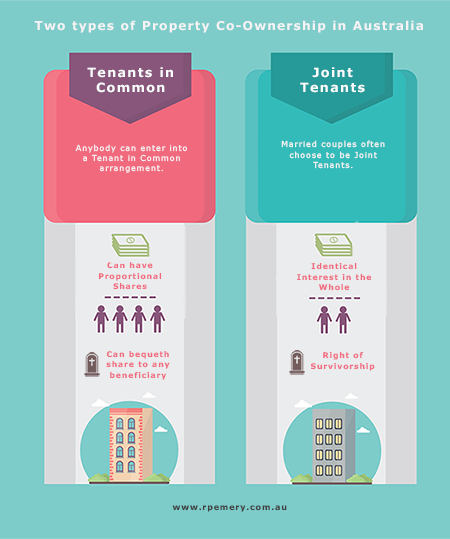Co-ownership is a effective way to achieve a goal of owning a property or thing (car, plane, boat). It’s a tool where you can use and enjoy the object while sharing the costs and risks associated with ownership.
This page will explain the different types of co-ownership, the pros and cons of co-ownership, answer FAQ’s about co-ownership and outline how to set up a co-ownership agreement or arrangement.
Co-ownership of property is where two or more parties own a real estate property or a thing, for example a boat or plane.
Co-ownership is a legal term used to describe a situation where multiple parties share an interest in an asset. Each co-owner will typically own a specific percentage of the asset. However, as shown below, this amount may vary depending on the type of ownership agreement in place.
There are two main types of property or real estate co-ownership. They include
The term “tenants in common” refers to a form of co-ownership where each party owns a distinct share in the property.
These shares can be split into different proportions, provided they add up to 100%. For example, Sally may own 25% of a property, while Morgan owns 75%.
We’ve written a whole article on the difference between joint tenants and tenants in common which includes this image which sums up the main differences.

It all depends on the purpose of the arrangement, how many co-owners are involved and the relationship between the parties.
Married couples or long-term de facto partners generally enter a co-ownership agreement as joint tenants. If one of the parties dies, this arrangement ensures that their interest in the property will pass on to the surviving joint tenant.
Tenancy in common, on the other hand, is a more flexible arrangement. It ensures that each co-owner will retain the right to distribute their share in the property to whomever they wish. For example, Sally and Morgan may decide to purchase a property as tenants in common so they can bequeath their respective interests in their Will to their two children.
For tenancy in common arrangements, lenders do not typically limit the liabilities of each co-owner in accordance with their distinct share in the property. This means that each co-owner is individually responsible for the entire debt. So, if one party defaults on the mortgage, it will be up to the other borrowers to make good the repayments.
Co-owners who hold as tenants in common can bequeath their share of the property in their Will to selected beneficiaries. After their death, each co-owner’s interest in the property will therefore pass on to whoever they wish to inherit that interest.
If there is no Will in place, the property will be subject to state specific intestacy laws.
An additional benefit of a tenancy in common arrangement is that each party enjoys the right to sell their share in the property without obtaining permission from the other co-owners.
A party can either decide to sell their fixed share in the property to an existing co-owner or a separate third party.
When a property is purchased as joint tenants, each party will automatically own a 50/50 or equal share. Therefore, joint tenants cannot nominate ownership shares.
When purchasing property as tenants in common, each party must agree on their precise share of the whole property. For example, if one party contributed 25% and the other 75% towards the property, this arrangement would be reflected on the title. If no percentage ownership is nominated, then the property will be deemed to be owned in equal shares.
It is possible to alter the ownership method by completing and lodging the relevant form with the Land Titles Office in your respective state or territory.
You can check out the following websites for more information:
VIC – https://www.land.vic.gov.au/
NSW – https://www.nswlrs.com.au/
QLD – https://www.titlesqld.com.au/
SA – https://landservices.com.au/
WA – https://www0.landgate.wa.gov.au/
NT – https://nt.gov.au/property/land
TAS – https://dpipwe.tas.gov.au/land-tasmania/land-titles-office
For real estate property where there are two or more tenants in common, you can use a Tenants in Common Agreement. This type of agreement.
The Agreement will set out the terms governing the co-ownership of the property, including such things as:-
Addressing these issues upfront will help ensure the relationship between the co-owners remains a success.
For other property – for example, car, boat or plane, you can use a Co-ownership Agreement or Fractional Ownership Agreement.
What’s the difference between Joint Tenancy and Tenants in Common?
Property co-ownership, it’s a team effort – Why two (or more) owners are better than one.
Investing with friends and family: a way to afford the great Australian dream